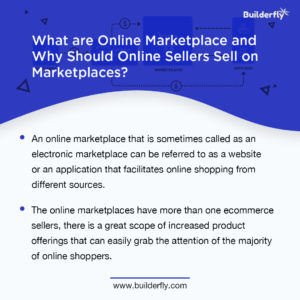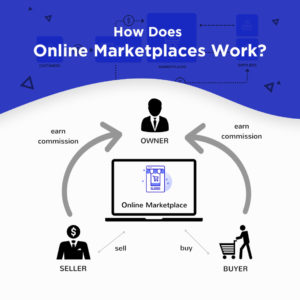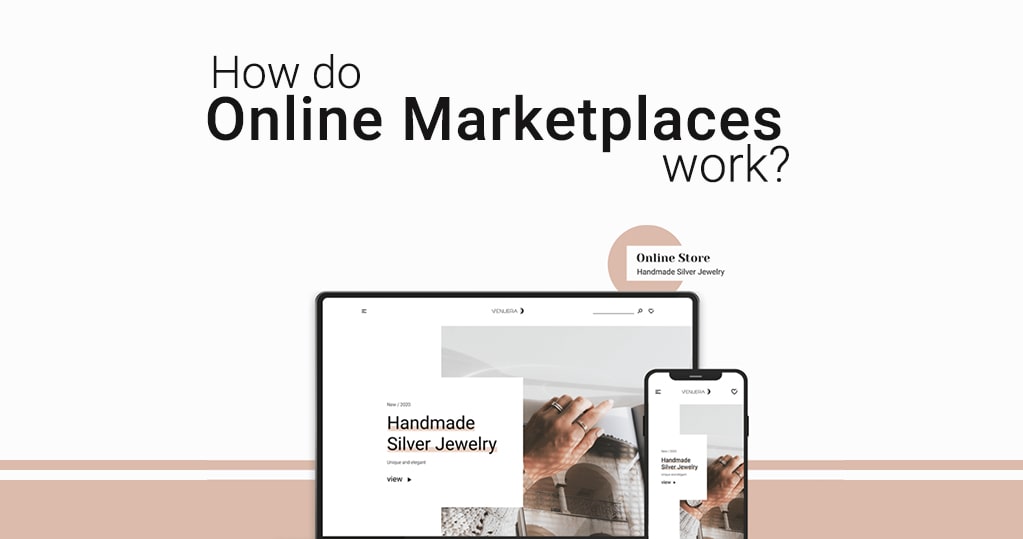Have you been to a market? Even as a child, we would have visited a market with our elders who are walking down the aisles of stalls with a variety of fruits, vegetable, and other products that are directly sold to the customers. As customers, you or any other purchaser selects the products you like, make the payments against the products and get the products in your bags. The concept of these physical markets is exactly how the online marketplaces. The only difference being; you do not have to walk on the streets of the market to find your desired products, you can do your shopping right when you are laying leisurely on your favourite couch. In cyberspace, you are browsing for the products you like, getting the price against them, making the payment, and the products get delivered to your doorsteps. In this blog, we will be discussing everything you need to know about these online marketplaces, and most importantly, let you know, how they work. If you are planning to start selling goods and services online or are already selling them, stay tuned to this blog, and you won’t be disappointed with the benefits you receive!
What are Online Marketplace and Why Should Online Sellers Sell on Marketplaces?

So, now comes the question, what exactly an online marketplace is? Let us answer your question. An online marketplace that is sometimes called as an electronic marketplace can be referred to as a website or an application that facilitates online shopping from different sources. It is a type of ecommerce business that can be quite rewarding when done right. It is basically an ecommerce site or app that other third-party companies can use to sell their goods and services to their consumers. Such online marketplaces connect a buyer and a seller through their website or app, playing the role of digital middlemen. The owner and manager of the marketplace do not own any inventories. In fact, their role is to showcase other people’s inventories to their audience and facilitate the transactions made to purchase the products. Multiple merchants can use the marketplace to sell their goods and services to the customers.
These online stores are termed as online marketplaces as there are multiple merchants selling on a single marketplace to sell goods and services to the customers who are browsing through the marketplace website or app. The traditional ecommerce stores, on the other hand, sell goods and services of a single brand. As the online marketplaces have more than one ecommerce sellers, there is a great scope of increased product offerings that can easily grab the attention of the majority of online shoppers. This is one of the major benefits of online marketplaces – it can lead to increased online traffic as compared to a traditional ecommerce website, which means, widened exposure of the brands that are not achieved the other way round. What attracts online sellers to marketplaces is that it follows a single checkout procedure. The customers purchasing from online marketplaces do not need to visit another website in order to complete a purchase; they can purchase products from different merchants at once from a single platform even when the different merchants are not connected with each other. Some of the prominent examples of marketplaces include Amazon, Flipkart, Etsy, eBay, and Airbnb.
When online shoppers purchase from a marketplace, the concerned merchant gets notified about someone purchasing their products. The merchant can then individually ship the products to the marketplace and the products that were ordered by the customers shall be delivered and fulfilled by the marketplaces. For instance, in Amazon, when a customer orders multiple products from different sellers, the sellers need to ship the products to the marketplace and it is then delivered to the customers after verifying the product, labelling, and billing them. The marketplaces thereafter deal with the customers for any queries regarding the orders and the seller plays no role in customer services. You must know that not every online shopping is done on marketplaces. For instance, when you are shopping for your monthly groceries from the store’s website, you are not purchasing from a marketplace. On the contrary, when you shop from Swiggy or Zomato – two of India’s leading food and essentials’ marketplaces, you shall find multiple sellers of the same products, which is an example of a marketplace. In a nutshell, selling goods and services using the online marketplaces can help online sellers get broadened customer exposure and increased sales as compared to selling solely on an online website or mobile app.
How Does Online Marketplaces Work?

Every marketplace has a unique hierarchy of functioning. However, we will be discussing about a general picture of how these online marketplaces actually work. The convenience offered by the marketplaces to the customers has resulted in it being the drivers of the internet economy across the globe. The marketplaces have been considered as the cash cows of online businesses by urging for liquidity via commissions, marketing, and other value-adding services. The marketplaces have today outdone all forms of internet sectors when it comes to generating online traffic. Online shoppers today trust such marketplaces with more options to choose from both large-scale as well as small-scale retailers rather than visiting multiple websites to purchase directly from the retailers.
Online marketplaces do not need to get into the hassles of maintaining inventories, logistics, product photos, product descriptions and other problems. They can simply transfer their burdens to the online sellers who can enjoy a dedicated space to manage the orders placed and sell their products. The online buyers can access the inventory of the suppliers’ and the real-time information of the products electronically. So how do these marketplaces work? Let us find out!
The sellers invest their money on the marketplaces in exchange for the widespread audience access from the platforms. The sellers upload their products on the marketplaces and the marketplaces further showcase and market the products to the relevant customers based on the keywords and other SEO optimizations. Here, the marketplaces play the role of a neutral facilitator connecting the sellers to a larger set of customers with minimal investments. Selling on a marketplace can potentially transform a local business into a global business if done right. What makes marketplaces a more preferred mode of selling is that the sellers get help with the payment and order processing as the marketplaces handle that part for the sellers and the buyers, on the other hand, can rest assured for the security of their orders and delivery based on the brand identity of the marketplace. For instance, when people order from popular marketplaces such as Amazon, they feel more secure about their orders being in safe hands rather than ordering from any random website seen on the social media platforms and other selling platforms. Usually, all the trusted marketplaces are ready with a dedicated support team round the clock even after delivering the products for assuring the best customer experience. This is what makes marketplaces loved by not only the customers but also the sellers. By selling on marketplaces, the sellers can focus on their major business, i.e. selling products and managing the stocks as per the demand.
Do you know how these marketplaces make money? Well, let us tell you. They draw various revenue options such as the Subscription-Based Model, Commission Model, Sign-Up Fees, Product-Listing, and Mixed Models. The subscription-based model is the most common of all the revenue options that include charging a fixed and recurring fee for the seller’s access to the marketplace. This model aids the sellers to find potential customers, for which, they subscribe to the marketplace. However, the marketplaces need to ensure that the sellers are getting the value for their investments. In the commission model, the marketplaces’ charge a fixed amount from the sellers for every sale they make. Sometimes, the marketplaces may charge, both, the sellers, as well as the buyers for every conversion. Unlike the subscription-based model, the sellers can operate the marketplace platform for free and make the payment only when they get value from the marketplace. As the name says, the sellers make a flat payment when they sign up in a marketplace in the form of a registration fee. As the sellers make upfront payment right when registering with the marketplace, there is no need for complicated payment gateways. In the product-listing revenue model, is most commonly used by two-sided marketplaces. The marketplaces here, charge the sellers with a flat amount while they list their products for sale. The marketplaces can opt not to stick to one revenue model and use the mixed model wherein they can combine several revenue models at once. By doing so, the marketplaces get access to several revenue sources. Amazon being one of the biggest marketplaces’ globally, uses the mixed model and is visibly successful in its game.
That was our contribution to provide you value about online marketplaces. We hope that this helps you in getting to know about everything for marketplaces. Happy selling!








